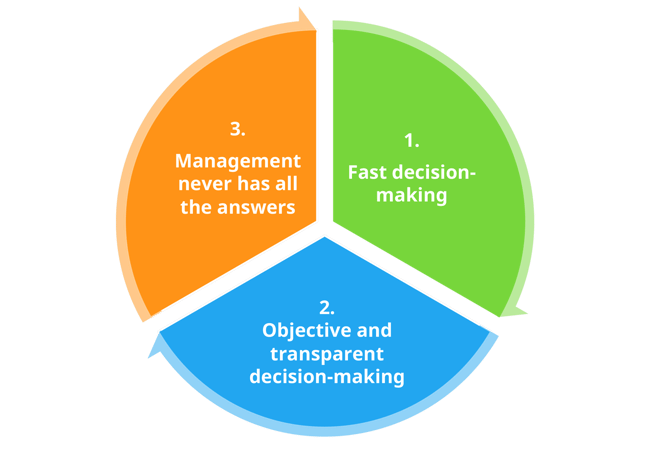How to Manage Ideas and Make Innovation Happen
One of the questions we often get asked about is how to actually “make ideas happen”. Most of the people asking this are ones we’ve just started working with, and who’ve already gathered lots of great ideas and are now finding it slightly overwhelming to think about what to do with them. However, any healthy organization will always have more ideas than they can implement, so there’s no need to worry.
The real challenge lies in managing those ideas effectively, which in its simplest, but probably not the most effective, form can mean prioritizing the ideas and then implementing as many of the top ideas as possible. This is what often separates top-performing companies from the rest. The ways in which this should be achieved will vary quite a lot depending on the organization, as well as the ideas themselves, so let’s dig a bit deeper.
Can you even manage ideas?
Many people, especially creatives, often find “innovation or idea management” as a paradoxical, or even insulting, concept. They argue that it is them, their abilities, and their freedom to experiment that will lead to new innovations and that innovation can’t be managed; anyone trying to do so will simply stifle any and all attempts at it.

However, in my opinion, that is a gross over-simplification. It is absolutely true that there are many executives and managers whose work is a hindrance for innovation, which is usually a result of them trying to apply their experience from operative work, such as sales management, to more creative work like R&D. These are fundamentally very different fields, requiring very different approaches. Innovation can absolutely be managed, but it can’t be done the same way you would manage an assembly line, even though there are certainly some similarities.
Order vs. Chaos – The Guiding Principles
According to Eric Schmidt, the ex-CEO of Google, the most innovative companies are in a constant state of “managed chaos”. They have an environment where people have lots of freedom for coming up with ideas, and even testing them out without prior permission, but they contrast that with a very rigorous and disciplined decision-making process for quickly killing off the ideas that don’t work.
This approach is so powerful due to a few key reasons, which we call the guiding principles on how to manage ideas:
- Decisions should be made quickly
- Decisions should be objective and transparent
- The management never has all the answers
Successful innovations are rarely the “overnight successes” that we often hear about, but almost always a result of a long process of learning and iterative improvements, no matter how ground-breaking the initial idea is. Thus, it’s critical for any decision-making process that aims for new innovations to be designed in a way that leads to quick decisions. If each step on the journey takes ages to complete, you’ll never get to the destination. At least not before your competitors do.

If your employees have lots of freedom to work on their ideas, you’re going to need plenty of transparency in the way you operate. It should be crystal clear for everyone to know where you’re going as a company, as well as what the general direction towards that is. Also, if people know what the criteria for making the decisions is going to be, they’re much more likely to take those aspects into consideration, which will obviously lead to more ideas being successfully implemented and people understanding the reasoning in question. This is why a systematic process for idea evaluation can be such a useful tool.
“A free-wheeling, idea-generating climate of open inquiry—like the one Schmidt cultivated at Google—has to be matched with disciplined decision-making in order to thrive”
Last, but not least, it’s crucial to understand that no matter how brilliant the executives are, management never has all the answers. Most executives have made tons of great decisions that got them were they are, but they’ve also likely made at least as many suboptimal or poor decisions along the way. This leads to survivorship bias, which can sometimes make it difficult for the management to remain humble and objective. In addition, since they typically have a long background in business, they’re likely to pattern match the ideas against commonly accepted “best practices” they’ve encountered.
If they’re making all the calls on which ideas to progress and which ones to not, they’ll most likely be able to kill off many of the “obviously bad ideas” but will inevitably also end up killing many of the “unobvious brilliant ideas” that simply don’t match their past experience.

While we’re big believers in empowering people and providing them with lots of freedom, there are often cases where it’s not reasonable, at least right away. For example, if you’ve been a hierarchical organization where employees have had very little freedom for ages, suddenly granting them complete freedom over their work is likely to only lead to chaos, as most of them aren’t used to it and many won’t be ready to raise up to meet the increased responsibility and expectations – without getting in some practice first. In these cases, we recommend you start by gradually increasing freedom in the parts of the organization where it a) makes most sense and b) where people are most prepared for it. No matter how you choose to proceed, you should keep the three guiding principles at the top of your mind.
So, what should we do in practice?
At this point, you might think that all of this is good and fine, but where should we start in practice? Well, as I’ve mentioned before, it depends. But to give you some ideas on where to go from here, there are a few examples that I can share. They are aimed for organizations with varying levels of preparedness, so hopefully you’ll find at least one of these to be inspirational or useful for your organization.
Ideation process with centralized decision-making
Most large organizations, including many of our customers, have a very traditional organizational structure and little experience in modern business development practices, such as Lean Startup methodology. For these companies, we recommend they start by creating a process for enabling their stakeholders to voice their ideas, and then making sure that many of the ideas will either be implemented or tested, one way or the other.

The exact design of this process can vary a lot depending on the types of ideas in question, as well as the organization itself. For example, software features are typically much easier, cheaper, and faster to implement than changes to a factory assembly line and thus require less input from different stakeholders prior to a decision. For more ideas on what these processes can look like in practice, please refer to our guide on idea management processes.
Here are, however, a few key success factors that we’ve identified to hold true regardless of the exact process you choose to implement:
- Culture and tools for allowing people to voice their ideas
- Mechanisms for quick-decisions to implement the obviously good ideas and test many others
- Tools and resources for quickly testing interesting (and controversial!) ideas
- Allocating a pre-defined pool of resources for implementing the ideas that are proven to work
- Employees need tools and time, but also budget: proven ideas shouldn't have to wait for a slice from next year’s budget.
Case Adobe Kickbox
Adobe Kickbox is an open-source innovation process and toolbox designed and first implemented by Adobe. It’s meant to be used by individuals within the company, but also serves as a means to deploy the process at scale across the company.
In practice, it’s a box containing what Adobe considers to be “everything an enterprise innovator needs”, including money (pre-paid credit card with $1000), instructions (process with checklists), other innovation tools (frameworks, exercises etc.), as well as caffeine and sugar (Starbucks gift card and a candy bar).

According to Adobe, it helps organizations to:
- Increase quantity, quality and speed of innovation
- Make innovators more effective
- Help engage currently inactive people with unlocked potential
- Improve the culture of innovation and help attract more talent
In the words of Mark Randall, Adobe VP of Creativity, the way the Kickbox achieves all of these goals is by focusing more on creating innovators, as opposed to simply looking for innovations. In order to do this, people around the organization have to get lots of experience in succeeding to innovate, and just as importantly, in failing during the process.
The Kickbox is simply a very scalable, affordable, and highly engaging way to do just that. It allows the organization to move faster and get more results with less investment, thus creating an organization that is more capable of scaling and sustaining their innovation activities.
“We’ve been able to do several hundred projects with less money than we did a dozen previously.”Mark Randall, Adobe VP of Creativity
Furthermore, Randall also thinks that “if you aren’t failing enough, you’re missing a lot of opportunities”. Many of the best ideas are often ones that are highly controversial, or even completely irrational, in the eyes of the people in the industry. Just consider how ridiculed the first mobile phones, antiseptic hand wash, or services like Airbnb were when they first started. Of course, those brilliant ideas are exceedingly rare, which is one of the key points of the whole Kickbox concept. You can’t simply choose to do a brilliant innovation, but you can increase the odds of creating one dramatically by increasing your capability to test and further develop ideas across the organization.
Case Facebook
My last example is slightly different. It’s not as much a process, as it’s an approach to building a scalable organization.
While Facebook has lately been the target of much criticism, they are in a league of their own when it comes to managing ideas. Letting people voice their ideas, test them out and see whether they make sense is simply a phenomenal way to scale an organization according to Facebook CEO Mark Zuckerberg.
To achieve this, Facebook has created an unparalleled infrastructure for testing new ideas. It allows anyone to deploy a new version of Facebook for a limited audience, for example 10,000 users, to test whether the idea makes sense or not whenever they want to. At any given point in time, there are likely to be dozens or hundreds of different Facebook versions out there with the majority of them testing a new idea.
“A lot of the decisions that I’m making are, ‘OK, is this going to destroy the company?’ Because if not, then let them test it.”Mark Zuckerberg
If you compare that to anything else, even the pace of ideas being tested at Adobe, a highly successful and innovative company, there’s a difference by an order of magnitude. The robust infrastructure allows Facebook to learn and move incredibly fast at scale, while still maintaining a high standard of quality. This approach is perfectly in line with the three guiding principles we introduced earlier. It removes the guesswork from decision-making on an operative level and allows the management to focus on the big picture while increasing both effectiveness and efficiency in the process.

Conclusion
While it probably isn’t feasible for your company to create as advanced of an infrastructure for testing ideas as Facebook has, you should still learn from it and strive to move towards that.
If you want to make faster progress as a company, you should focus on building systems and processes that make it effortless for people to test ideas. And while you’re at it, remember to educate your employees on where you’re going and how to proactively progress their ideas to help you reach those goals. When people are given permission to work on things they consider important, they are likely to be much more engaged and productive. As a result, the organization is going to have a much healthier culture going forward.
However, with the increased freedom, it is absolutely crucial that everyone truly understands the organization’s current situation, goals, and strategy. While you might see this as obvious, remember that many employees in most organizations don’t really need to know or care about the company’s financial situation or strategy, which means that these topics won’t naturally be at the top of their minds.
The bottom line is that to drive progress and make more (and the right) ideas happen, you should aim to build a culture based on testing and iterating ideas on all levels of the organization. To quote Steve Blank, “No business plan survives first contact with a customer”, and the same principle applies for the vast majority of ideas. The sooner you’re able to test your ideas, the more you will learn, and the more you will achieve down the road.
When you start building your own infrastructure for testing and progressing ideas, just keep our three guiding principles in mind and don’t worry about getting it right the first time around. Building the infrastructure is inevitably going to be an iterative process in itself.
You just need to make the first steps. We encourage you to get started with Viima. It's free for unlimited users! If you have questions, don’t hesitate to be in touch!






